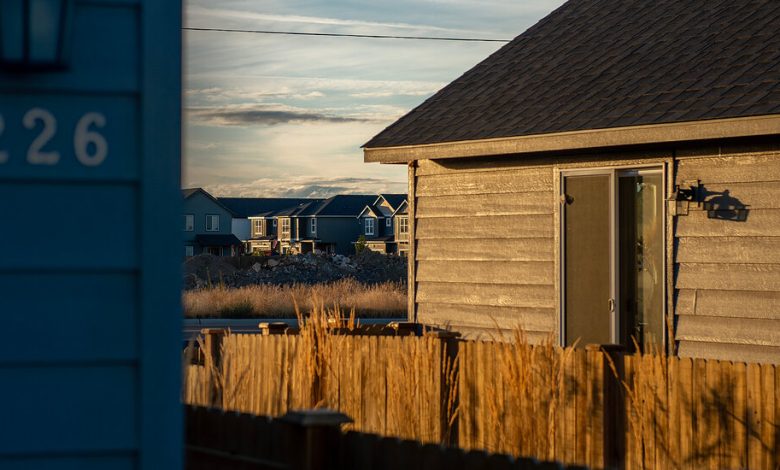A Higher Monthly Payment, but Less Square Footage

The American home is shrinking.
With interest rates rising and mortgage costs with them, homebuilders are pulling in yards, tightening living rooms and lopping off bedrooms in an attempt to keep the monthly payment in line with what families can afford. The result is that new home buyers are paying more and getting less, while far-flung developments where people move for size and space are now being reimagined as higher-density communities where single-family houses have apartment-size proportions.
In a recent survey of architects, John Burns Research and Consulting found that about half expected their average house size to decline. New communities will have more duplexes or small-lot single-family homes that are just a few feet apart. Even in Texas, where land is abundant, builders are adding more homes per acre, the company found.
“The monthly payment matters more than anything else and builders have responded with smaller, more efficient homes,” said John Burns, the company’s chief executive.
Consider Hayden Homes, a Pacific Northwest builder that focuses on small towns and exurbs where middle-class families (its typical buyer has a household income of $90,000 a year) have historically traded more house for a longer commute.
Two years ago, when interest rates were low, the average Hayden home was a 1,900 square-foot three-bedroom that cost $500,000, or about $2,000 a month, said Steve Klingman, the company’s president, in an interview. This assumed a 5 percent down payment and a 30-year fixed-rate mortgage with a 3 percent interest rate.
Now, as borrowing costs consume more of buyers’ mortgage payments, Hayden is lowering prices and square footage to keep customers’ payments stable. The average Hayden home is now 1,550 square feet and costs about $400,000, or $2,100 a month, Mr. Klingman said. To buy it, however, a customer has to produce a 10 percent down payment and, even with incentives, is paying a 6 percent rate on a 30-year fixed-rate mortgage.
“We are reconfiguring our floor plans, our features and community design all to get to that payment buyers can afford,” Mr. Klingman said. “People want to own if we can make it attainable.”
In dense areas like Southern California, the high cost of land has long led developers to focus on compact homes. Trade-offs like a side yard instead of a backyard, or a garage that opens to the street instead of a driveway, have compressed size and reduced cost. Now those kinds of urban designs are arriving in the exurbs.
For instance, in Hayden’s hometown, Redmond, Ore., a city of 35,000 about 30 minutes from Bend, Ore., its Cinder Butte Village development now has homes as small as 400 square feet (a one-bedroom, one-bath with a garage on the back alley). The average is around 1,000 — half the typical home size in the community two years ago.
Mr. Klingman expects smaller homes to drive the market in the coming years. Hayden shifted all of its floor plans down as mortgage rates started rising and has prototypes for new communities that are twice as dense as the ones it built during the pandemic.
“I think this is for the long haul,” Mr. Klingman said.
New homes are a tiny slice of the U.S. housing stock — builders started about 1.5 million houses and apartments last year, while 142 million already existed — but since they are built in every market and bought almost entirely with mortgages, their size and cost are relatively sensitive to changes in the economy. This makes fresh construction a useful picture of how families are affected by higher borrowing costs.
American families have for generations had more space than households elsewhere in the developed world, but their homes were shrinking even before interest rates rose. The median new U.S. home peaked around 2,500 square feet in 2015. Over the next five years, new homes shed about 200 square feet as costs rose, urban living boomed and smaller families became more common.
The pandemic, with its rock-bottom interest rates, led to what seems poised to be a short-lived increase. As white-collar workers ditched their commutes, and home-based offices went from perk to necessity, builders added rooms and exurban subdivisions thrived.
Today’s buyers are dealing with the hangover. The average rate on a 30-year fixed-rate mortgage has roughly doubled over the past two years, to 7.57 percent, according to Freddie Mac. This has all but frozen the market for existing homes by making buyers who locked in low rates reluctant to trade up or move, keeping home prices stable despite a huge increase in borrowing costs.
The price that sellers will accept “is unusually high,” said Daryl Fairweather, chief economist at Redfin, the real estate brokerage. “They need somebody to buy them out of their mortgage.”
The decline in the inventory of existing homes for sale has made new homes a much bigger slice of the market. New home sales have consumed about a third of the market this year, or double the level in 2019, according to Redfin.
Homeowners who can’t get their price can always sit out the market. But homebuilders have to sell to survive. And in a market where borrowing costs are consuming more of their buyers’ payments, and after years of rising material and labor costs, that means selling less house.
The cuts will not be equal. In its survey, the John Burns consultancy found that dining and children’s rooms are being sacrificed to preserve bigger kitchens and primary bedrooms. To do this, builders are replacing tubs with showers. They’re expanding kitchen islands so they double as a dinner table. Outdoor spaces are being connected by covered patios and wall-size sliding doors that make a smaller living room seem open.
Bigger is still better, even if it only feels like it.



